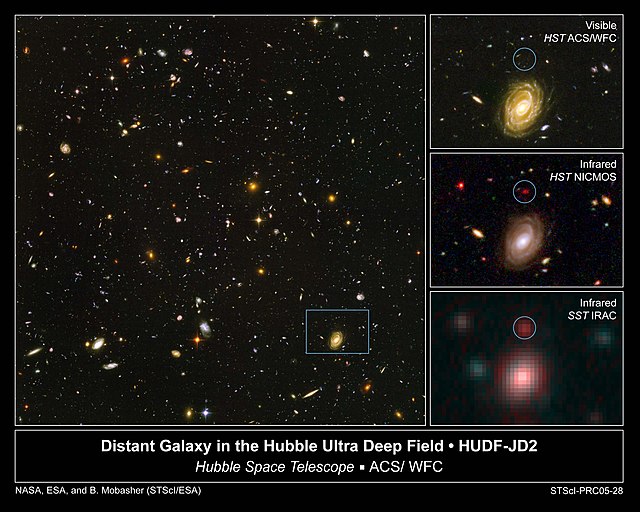List of largest infrared telescopes
From Wikipedia, the free encyclopedia
The largest infrared telescopes for infrared astronomy are listed in terms of diameter of primary mirror. The infrared spectrum with its longer wavelength than visible light has a number of challenges, especially for ground-based observatories but also in space. Notably infrared radiation is emitted by all physical objects above Absolute Zero temperature so telescopes are subject to local interference.
This article needs additional citations for verification. (November 2011) |
This list has no precise inclusion criteria as described in the Manual of Style for standalone lists. (June 2022) |

Overall
Summarize
Perspective
Infrared observations from Earth's surface are possible in a limited way but can be very dependent on location and atmospheric conditions. Water vapour in the Earth's atmosphere blocks much of the infrared band, although some limited observations are possible and there is a number of infrared observatories.
Sometimes other optical telescopes can make infrared observations if they are equipped with the right detectors, even if they are not dedicated infrared observatories. For ground-based observatories, the location can make a big difference in how much observation is possible.
| Name | Image | Effective aperture | Wavelength Coverage | Site | Year(s) | Refs |
|---|---|---|---|---|---|---|
| TAO telescope | 6.5 m (260 in) | 0.9-38 μm | University of Tokyo Atacama Obs., Chile | 2024 | [1] | |
| James Webb Space Telescope |  | 6.5 m (260 in) | 0.6-28.5 μm | Space, Sun-Earth L2 | 2022- | |
| VISTA |  | 4.1 m (160 in) | 0.85 – 2.3 μm | Paranal Obs., Chile | 2008 | [2] |
| Eastern Anatolia Observatory | 3.94 m (155 in) | 0.9 – 2.5 μm | Erzurum, Turkey | 2024 | [3][better source needed] | |
| United Kingdom Infrared Telescope |  | 3.8 m (150 in) | 0.8 - 20 μm | Mauna Kea Obs., Hawaii | 1978 | |
| Herschel Space Observatory |  | 3.5 m (140 in) | 60-672 μm | Space, Sun-Earth L2 | 2009-2013 | [4] |
| Infrared Telescope Facility | 3.2 m (130 in) | 0.8 - 25 μm | Mauna Kea, Hawaii | 1979 | [5] | |
| SOFIA | 2.5 m (98 in) | 0.3 - 655 μm | 747SP; Stratosphere | 2010-2022 | [6][7] | |
| Wyoming Infrared Observatory |  | 2.3 m (91 in) | 0.4 - 0.8 μm | Jelm mountain, 9656 ft. (2943m) | 1977 | [8] |
Space telescopes only


| Name | Effective aperture cm (in) | Wavelength Coverage | Year | Refs |
|---|---|---|---|---|
| James Webb (JWST) | 650 cm | 0.6-28.5 μm | 2021- | |
| Herschel Obs. | 350 cm (138 in) | 60-672 μm | 2009 - 2013 | [4] |
| Hubble WFC3 | 240 cm | 0.2-1.7 μm | 2009 - | |
| Euclid NISP | 120 cm | 0.92-2.02 μm | 2023 - | |
| Spitzer | 85 cm | 3-180 μm | 2003 - 2020 | [6] |
| Akari | 68.5 cm | 2-200 μm | 2006 -2011 | [6] |
| ISO | 60 cm | 2.5-240 μm | 1995-1998 | [6] |
| IRAS | 57 cm | 5-100 μm | 1983 | [6] |
| NEO Surveyor | 50 cm | 4–5.2 & 6–10 μm | 2028 (planned) | [9] |
| WISE/NEOWISE | 40 cm | 3-25 μm | 2009-2011 & 2013 - | [6] |
| MSX | 33 cm | 4.3-21 μm | 1996 - 1997 | |
| SPHEREx | 20 cm | 0.75 to 5.0 μm | 2025 - | |
| Spacelab IRT | 15.2 cm | 1.7-118 μm | 1985 Aug | [10] |
See also
- Lists of telescopes
- Infrared telescope
- List of largest optical reflecting telescopes
- Space Flyer Unit
- Diffuse Infrared Background Experiment (all-sky infrared observation on COBE, launched 1989)
References
Wikiwand - on
Seamless Wikipedia browsing. On steroids.
